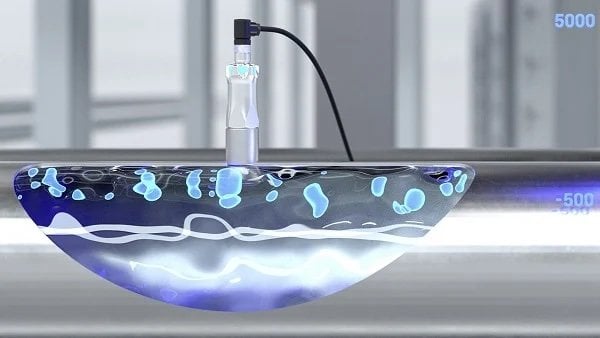www.industry-asia-pacific.com
10
'22
Written on Modified on
Preventing dry run and cavitation
Innovative sensor to protect pumps against gas bubbles. A new type of sensor efficiently protects pumps against dry run and cavitation. With PAD20, sensor expert Baumer presents an intelligent solution for varied applications and industries.

Thanks to sophisticated algorithms, PAD20 will recognize very precisely any presence of gas in the fluid flow.
The principle is simple: The innovative PAD20 analysis sensor will quickly and reliably detect even tiniest bubbles of air and gas in fluids. Thanks to the smart sensor principle, it will immediately report any individually adjustable limit for gas inclusions being exceeded. The signal can be used for pump shut down or for reporting an alarm warning. “The sensor also signals whether a closed system is free of gas bubbles. The digital IO-Link interface provides valuable secondary data, for example for condition monitoring: Customers can track the amount of gas inclusions in the system”, says Baumer Product Manager Julian Budde.
Early detection of gas bubbles in fluids is effective pump protection. Cavitation and dry run are constant risks in pump operation and often entail high costs. Bubbles of gas or air in the pumped medium can damage the pump, causing expensive malfunction and high maintenance costs.
Applications from brewery to heating technology
PAD20 will prevent pumps from harmful gas pockets for extended service life. Thanks to precise detection early on, the sensor also will reduce maintenance effort and downtime. PAD20 can increase overall plant effectiveness in industrial and hygienic applications. Little matter what's the medium's consistency: PAD20 works reliable both in fluids such as milk and in viscous media like oil.
Wherever pumps are used, PAD20 will ensure operational capability: in industrial applications, food production, building technology or water supply. More target applications are monitoring of cooling circuits and dry run prevention, process monitoring and ensured process reliability in terms of pump protection.
The sensor measuring principle is dc-value based detection (dc = dielectric constant) of air and gas bubbles in fluids with a minimum conductivity of dc > 1.5. “Thanks to sophisticated algorithms, PAD20 will recognize very precisely any presence of the fluid flow. Independent of the medium, the sensor measures dc deviation and this way provides maximum flexibility”, explains Julian Budde. Two individually defined switching ranges allow users to optimally adjust the sensor to the process requirements.
www.baumer.com
The principle is simple: The innovative PAD20 analysis sensor will quickly and reliably detect even tiniest bubbles of air and gas in fluids. Thanks to the smart sensor principle, it will immediately report any individually adjustable limit for gas inclusions being exceeded. The signal can be used for pump shut down or for reporting an alarm warning. “The sensor also signals whether a closed system is free of gas bubbles. The digital IO-Link interface provides valuable secondary data, for example for condition monitoring: Customers can track the amount of gas inclusions in the system”, says Baumer Product Manager Julian Budde.
Early detection of gas bubbles in fluids is effective pump protection. Cavitation and dry run are constant risks in pump operation and often entail high costs. Bubbles of gas or air in the pumped medium can damage the pump, causing expensive malfunction and high maintenance costs.
Applications from brewery to heating technology
PAD20 will prevent pumps from harmful gas pockets for extended service life. Thanks to precise detection early on, the sensor also will reduce maintenance effort and downtime. PAD20 can increase overall plant effectiveness in industrial and hygienic applications. Little matter what's the medium's consistency: PAD20 works reliable both in fluids such as milk and in viscous media like oil.
Wherever pumps are used, PAD20 will ensure operational capability: in industrial applications, food production, building technology or water supply. More target applications are monitoring of cooling circuits and dry run prevention, process monitoring and ensured process reliability in terms of pump protection.
The sensor measuring principle is dc-value based detection (dc = dielectric constant) of air and gas bubbles in fluids with a minimum conductivity of dc > 1.5. “Thanks to sophisticated algorithms, PAD20 will recognize very precisely any presence of the fluid flow. Independent of the medium, the sensor measures dc deviation and this way provides maximum flexibility”, explains Julian Budde. Two individually defined switching ranges allow users to optimally adjust the sensor to the process requirements.
www.baumer.com

